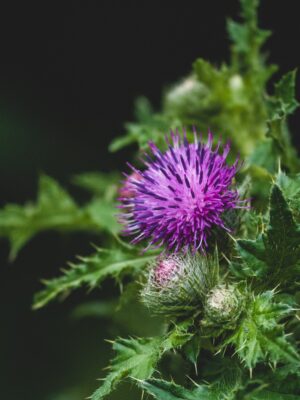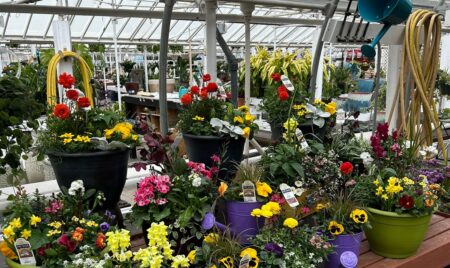By Meagan Provencher
Weeds aren’t a very glamourous garden topic but they seem to be making up the largest pile of our garden questions from clients this year. Weeds are like gray hairs – we all have them and the more you pull them, the more you get! While there isn’t a fail proof method for preventing weeds, there are lots of options to help make your routine garden chores easier. Here’s some common garden weeds that we see in most gardens as well as some suggestions for prevention and eradication.
Dandelions are fairly easy to pull or pop out of the ground and generally don’t make a nuisance of themselves if you don’t let them go to seed. If you don’t use chemicals on your lawn or gardens, their foliage is edible too! I generally don’t get too bent out of shape if a dandelion or two pop up in the yard because the bees like them but if they get a little out of hand in the garden, I do pull them.
 Thistles are one of the toughest to get rid of because their roots break off when you pull them and create a new baby thistle that pops up a week later! Generally, I try to avoid the use of chemicals if I can, but thistles are one weed that warrants pulling out the Weed-B-Gone to kill. Follow the directions for use of course and just spray the thistle leaves. Use common sense and don’t spray on a windy day or get all crazy, willy-nilly with the spray wand, and you’ll see results almost immediately. Let the thistle carcass dry up and it will just disintegrate. Again, I rarely use chemicals and usually it’s only on thistle because they are jerks.
Thistles are one of the toughest to get rid of because their roots break off when you pull them and create a new baby thistle that pops up a week later! Generally, I try to avoid the use of chemicals if I can, but thistles are one weed that warrants pulling out the Weed-B-Gone to kill. Follow the directions for use of course and just spray the thistle leaves. Use common sense and don’t spray on a windy day or get all crazy, willy-nilly with the spray wand, and you’ll see results almost immediately. Let the thistle carcass dry up and it will just disintegrate. Again, I rarely use chemicals and usually it’s only on thistle because they are jerks.
Bindweed is the bane of our existence. What looks like a cute little white morning glory popping up in the garden becomes a vicious plant strangler that gets caught up in just about everything and is impossible to pull. While flamethrowers aren’t totally out of the question, usually we recommend gently pulling at the base after a good rain (or water it the day before) and try to pull out as much of the root as you can. If you are patient, you can paint herbicide on the leaves with a small paintbrush to get the worst of the bindweed that ends up tangled with good plants. It is hard to spray direct from a bottle because it winds itself into plants too tight.
Weeds pop up wherever they wish but if they are popping up in your mulched beds, often it is from seeds that blow in from the local flora or from the lawnmower. If you catch them right away, you can just rake up the mulch which will pull out the tiny seedling and kill them. If you leave them for too long, they will root into the soil below the mulch and require a bit more effort to remove. Schedule time each week to rake up your landscape beds to keep seedlings at bay. There are pre-emergent herbicides in granular form that you can apply in early spring/mid-summer over your mulch which help also. I highly recommend adding a Dutch hoe to your tool box. They are amazing tools – mine is a DeWit Diamond Hoe with a “P” handle and I LOVE it – and they cut through weed roots like butter. They make quick work of weeds in large gardens and in tight places where a standard garden hoe wouldn’t fit.
You can also keep weeds at bay using groundcovers and plants with larger leaves. When plants are left to their own devices, they will fill in and provide excellent cover to their own roots. This also squelches any weed seeds that make it to the landscape bed. If you have “open real estate” in your gardens, the weeds will win. If your garden is properly planted and plants are spaced for mature growth and overhang, the plants will do your weeding for you! Don’t leave large open spaces in the landscape for weeds to take hold of.
In the grand scheme of things, I don’t get to upset over weeds in my garden. It gives me something do to each week and allows me to spend some time in the garden observing the good plants and planning for more. I would guess I rarely spend more than 2 hours a week weeding – and I have lots of gardens! Instead of being angry at the weeds, think of it as garden therapy that you can lose yourself in each and have a great sense of accomplishment when you are done!
Meagan Provencher is the Senior Landscape Designer for Wasco Nursery. She can be reached at 630-584-4424 or design@wasconursery.com








